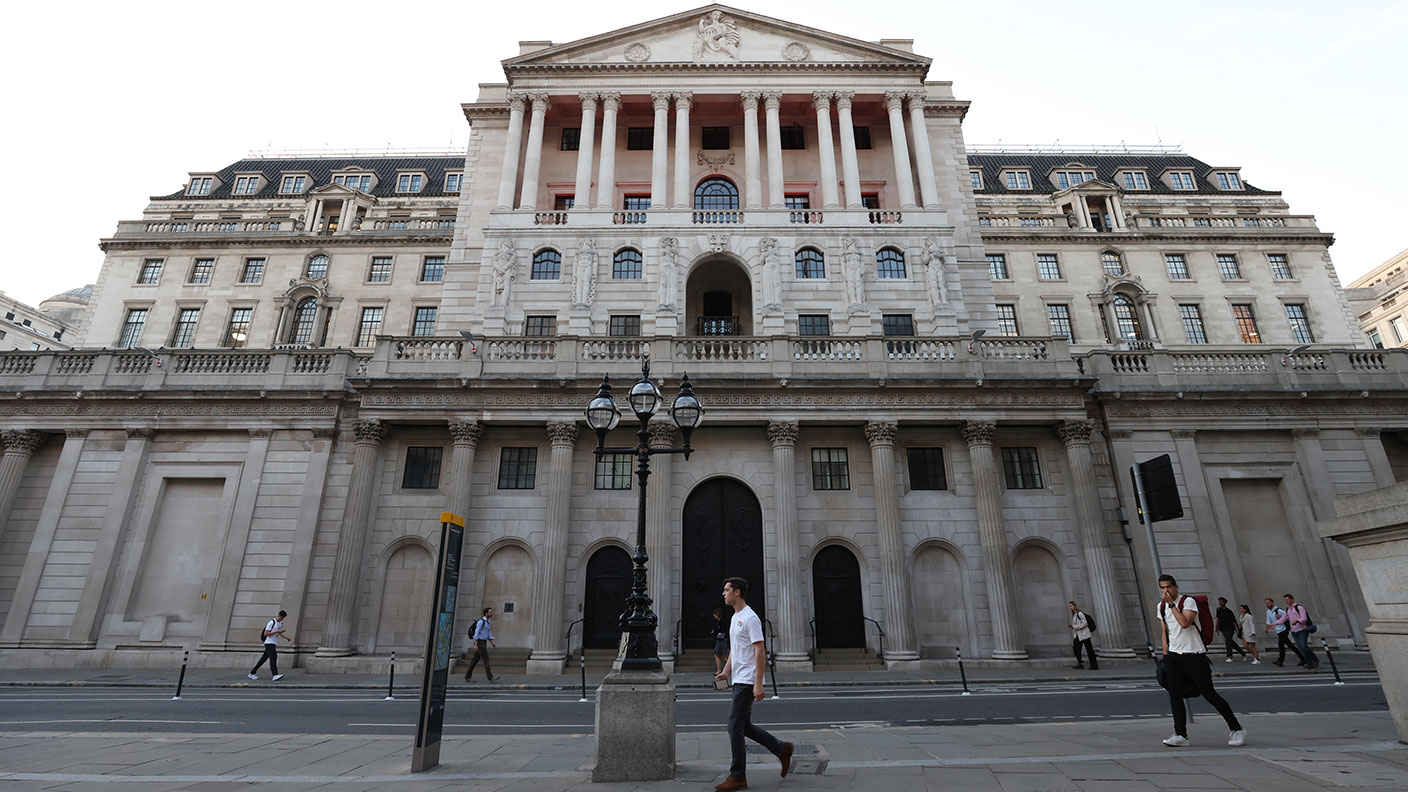Is inflation about to drop as recession takes hold?
Central banks are raising interest rates in an attempt to curb soaring inflation. But will that push the economy into recession? John Stepek looks at how we got here and where things might go next.


Before I get started this morning, make sure to get your tickets for this year’s MoneyWeek Wealth Summit. We’ve already got some brilliant speakers lined up, and everything I discuss in this morning’s piece will be dissected in detail there, along with its investment implications. Book now!
So what are we talking about today?
It’s the same old story as always – are we heading for inflation or recession or both, and what might central banks do about it, and what does all of that mean for your money?
MoneyWeek
Subscribe to MoneyWeek today and get your first six magazine issues absolutely FREE

Sign up to Money Morning
Don't miss the latest investment and personal finances news, market analysis, plus money-saving tips with our free twice-daily newsletter
Don't miss the latest investment and personal finances news, market analysis, plus money-saving tips with our free twice-daily newsletter
We have just got to the point in this story where central banks had agreed that inflation was not transitory at all and that they needed to raise interest rates to stifle activity and thus slow inflation.
However, people are now very much worrying that with the cost of living rising and clearly squeezing consumers, central bankers have come to this view too late, and that all they will achieve by raising interest rates is to push the economy into recession.
So let’s have a look at how we got here and try to figure out what’s most likely. This is going to be part one in a short series, as I don’t think I can tackle all the variables in one article (well, not without you going to sleep by the end of it, at least).
The “staying in” versus the “going out” economy
We sometimes say that the pandemic shut the economy down in early 2020. But that’s not really accurate. What happened is that a large chunk of the economy was shut down as people were forced to stay in their homes. But people largely maintained or even improved their incomes due to furlough schemes, which meant that demand remained constant.
Sometimes this is described as a divide between goods and services. But that’s not that helpful. Watching Netflix is a service. But buying indoor exercise equipment from Amazon is a good.
So let’s split it into “going-out” businesses and “staying-in” businesses. Supply of the former was cut off. So the remaining demand went into the latter, which enjoyed a boom.
As a result, a couple of things happened. Companies in the “going-out” sector – pubs, restaurants, and the like – largely survived as going concerns due to government assistance. But there was no demand for their services. So they weren’t hiring or stocking up for an uncertain future.
Meanwhile, anyone who sold goods or services to people stuck in their houses – the “staying-in” sector – saw demand surge. Business for these companies boomed, and in many cases, they appear to have assumed that this demand would continue forever – or that at least some of it would stick permanently.
This assumption may seem irrational – or at least rather optimistic – but you have to remember that there are a lot of incentives for individual managers to extrapolate good growth into the distance. Everyone loves a boom and wants to take responsibility for it, whereas bad news is always something else’s fault.
One part of the economy over-ordered while the other under-ordered So what does that add up to? In the first instance, it adds up to one chunk of the economy – the bit that shutdown – effectively under-investing for the future, while the remaining half effectively over-invested for the future.
This has manifested itself in lots of different ways. One obvious example is at the big supermarkets in America. Walmart and Target are among the highest profile shops struggling with big inventory backlogs.
They’ve over-ordered for two reasons – when the economy shut down, supply chains became very unreliable and getting stuff to customers was harder. Better to over-order and meet soaring consumer demand.
But timing that sort of thing is tough. Once some semblance of normality started to return, demand dropped off (as consumers started to want “going-out” goods and services rather than “staying-in” ones), and the supply difficulties lessened, which meant that unsold stuff started to pile up.
Do remember that these companies are logistics experts – you have to be, you’re basically running a logistics business. So if they’re having problems, most companies are having similar issues.
This effect also accounts for big queues at airports this year. Too much demand meeting an industry which has been hammered by shutdowns for the best part of two years.
It also more than likely accounts for the odd employment picture we have today. We have the mystery of missing workers, which some have put down to early retirement (certainly a possibility) or migrant workers leaving the country (there’s truth to this though as it’s happening everywhere, arguably that should be a wash).
But the whole lagging impact of the shutdown makes some sense of this too. Take a simple example: pubs and restaurants shut down, but supermarkets and warehouses are hiring. Staff leave the restaurants and go to work at the supermarkets. Many find they like it better.
You go through a situation where “staying-in” sectors over-hire due to high volumes of business. “Going-out” businesses don’t hire at all. Then, just as the “staying-in” sector is starting to see a turn, the “going-out” sector is understaffed and desperate for more workers. So you get this lag.
If inflation is transitory and recession is already here, central banks may have to cut
Fundamentally, all of this is what lies behind the argument that inflation has been “transitory”. The pig is making its way through the python. It causes a lot of distortions and discomfort on its way through, but in the end, supply and demand get somewhere back to normal.
This implies that somewhere in the near future, we’re facing gluts of all the things we had shortages of (so graphics cards might get cheap, say, which is why Nvidia and Taiwan Semiconductor are down heavily in the last six months, say).
It also implies that the labour market may not remain as hot as it has been as the “staying-in” companies rein in their spending and expansion plans, and the consumer “glut” of savings is chewed up in expensive energy bills.
Which in turn implies that inflation might start to look less ugly, and that central banks might end up having to eat their words and flip around before the end of the year.
This is an outcome that markets appear to be pricing in rather quickly, with many arguing that a recession may already have begun.
So that’s the argument for inflation being “transitory”, and a recession being baked in. And it’s a pretty compelling argument. Is there a case against it – or at least, a different view? We’ll return to that tomorrow.
Meanwhile, Merryn and I discussed some of these points on the latest podcast – if you haven’t listened to it yet, have a listen here (we also chat about bitcoin if that’s your thing).
SEE ALSO:
Even if we end up in recession, a more inflationary world awaits us
Get the latest financial news, insights and expert analysis from our award-winning MoneyWeek team, to help you understand what really matters when it comes to your finances.
John Stepek is a senior reporter at Bloomberg News and a former editor of MoneyWeek magazine. He graduated from Strathclyde University with a degree in psychology in 1996 and has always been fascinated by the gap between the way the market works in theory and the way it works in practice, and by how our deep-rooted instincts work against our best interests as investors.
He started out in journalism by writing articles about the specific business challenges facing family firms. In 2003, he took a job on the finance desk of Teletext, where he spent two years covering the markets and breaking financial news.
His work has been published in Families in Business, Shares magazine, Spear's Magazine, The Sunday Times, and The Spectator among others. He has also appeared as an expert commentator on BBC Radio 4's Today programme, BBC Radio Scotland, Newsnight, Daily Politics and Bloomberg. His first book, on contrarian investing, The Sceptical Investor, was released in March 2019. You can follow John on Twitter at @john_stepek.
-
 ‘Why I have ditched my Help to Buy ISA for cash savings and the stock market’
‘Why I have ditched my Help to Buy ISA for cash savings and the stock market’Without the 25% bonus, my Help to Buy ISA is effectively redundant, says MoneyWeek writer Sam Walker.
-
 Is your inheritance tax allowance cut if you sell to downsize or sell your home to pay for care?
Is your inheritance tax allowance cut if you sell to downsize or sell your home to pay for care?Downsizing relief is a little-known benefit that could save your loved ones tens of thousands of pounds in inheritance tax after you’ve died.
-
 UK wages grow at a record pace
UK wages grow at a record paceThe latest UK wages data will add pressure on the BoE to push interest rates even higher.
-
 Trapped in a time of zombie government
Trapped in a time of zombie governmentIt’s not just companies that are eking out an existence, says Max King. The state is in the twilight zone too.
-
 America is in deep denial over debt
America is in deep denial over debtThe downgrade in America’s credit rating was much criticised by the US government, says Alex Rankine. But was it a long time coming?
-
 UK economy avoids stagnation with surprise growth
UK economy avoids stagnation with surprise growthGross domestic product increased by 0.2% in the second quarter and by 0.5% in June
-
 Bank of England raises interest rates to 5.25%
Bank of England raises interest rates to 5.25%The Bank has hiked rates from 5% to 5.25%, marking the 14th increase in a row. We explain what it means for savers and homeowners - and whether more rate rises are on the horizon
-
 UK inflation remains at 8.7% ‒ what it means for your money
UK inflation remains at 8.7% ‒ what it means for your moneyInflation was unmoved at 8.7% in the 12 months to May. What does this ‘sticky’ rate of inflation mean for your money?
-
 Would a food price cap actually work?
Would a food price cap actually work?Analysis The government is discussing plans to cap the prices of essentials. But could this intervention do more harm than good?
-
 Is my pay keeping up with inflation?
Is my pay keeping up with inflation?Analysis High inflation means take home pay is being eroded in real terms. An online calculator reveals the pay rise you need to match the rising cost of living - and how much worse off you are without it.
